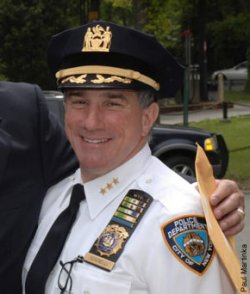Will NYPD’s Next Transpo Chief Make Safety Priority #1?
We’d been hearing rumors for weeks, and today NYPD confirmed that Chief of Transportation Michael Scagnelli is retiring. His last day is tomorrow.
 Chief Michael Scagnelli. Photo: New York Post
Chief Michael Scagnelli. Photo: New York PostScagnelli’s departure is not really a surprise, considering that it’s required by law. But the news is still significant in that his successor will step into the job at a time when the city is devoting more and more space to pedestrians and cyclists, even as NYPD all too often continues to treat those who traverse the streets outside of an automobile as second-class citizens worthy of scorn and harassment, when they merit any attention at all.
In 2007, police news outlet Officer.com ran a feature on Scagnelli, which offered this telling insight into departmental priorities:
Scagnelli lives and breathes the NYPD traffic-related mission statement:
Move Traffic, Move Traffic, Move Traffic,
Reduce Accidents, Move Traffic,
Reduce injuries related to accidents, Move Traffic,
Reduce deaths related to accidents, Move Traffic!
Despite the apparent emphasis on unimpeded traffic flow as his ultimate goal, Scagnelli gets high praise for his efforts to reduce injuries and deaths at the hands of motorists. After the jump, Nassau County ADA Maureen McCormick, a former Brooklyn prosecutor whose work marks the cutting edge of traffic justice in New York State, offers her take on Scagnelli’s tenure.
Chief of Transportation Michael Scagnelli
is both a maverick and an icon in the area of traffic justice. He understands that the violent assaults and homicides committed by dangerous
drivers are criminal — not just a cultural anomaly. His commitment to create
policies and procedures to improve police training, responsiveness, and effectiveness
is unmatched. Chief Scagnelli is the original “can do” police
professional who simply will not take “no” for an answer. During my
tenure with the Brooklyn District Attorney’s Office, I had the
opportunity to observe the chief institute “Traffic Stat” which
held local precinct commanders accountable for the traffic activity —
good and bad — within their confines. This focus sent a clear message
from the top that these offenses matter; that people’s lives were
endangered by dangerous driving and that the NYPD could make a real difference.
Chief Scagnelli made that difference which is reflected in the statistics.
In my opinion Chief Scagnelli’s shoes will be nearly impossible to
fill. It is unfortunate that archaic retirement laws will deprive the
people of New York City
from receiving the benefit of his experience and tenacity. No one (not
even the Chief) would claim that there is not more work to be done in the field
of traffic justice but we are losing an accessible, dynamic soldier in this
war. The success of Traffic Stat is a model that other departments have
followed. Let us hope the NYPD will continue to lead in this fight after
the Chief retires. Best wishes Chief! And thank you for the work
you have done on our behalf.
Transportation Alternatives Executive Director Paul Steely White agrees that drivers who break the law were more likely to be ticketed under Scagnelli’s watch, but points out that the need for further improvement is as urgent as it is blatant:
"Under Scagnelli, the number of
tickets written for blocking bike lanes, not yielding to pedestrians and other life
threatening offenses increased dramatically. So why is dangerous driving still
so rampant on NYC streets? What combination of new enforcement policies will
finally bring order to our lawless streets? Scagnelli’s successor
must answer these questions."
With DOT’s unprecedented strides in people-oriented street reclamations, and a change at the Manhattan district attorney’s office also set to take place in the near future, the stage is set for a new era of law-enforced civility in what most anyone would admit is still an overly dangerous environment for able-bodied pedestrians and cyclists, much less children, the elderly, and physically impaired. NYPD would not offer immediate comment on who might (or might not) help usher in this age of safer streets, but we’re keeping our ears to the ground.